Exhibits
Preface
In 2000, Special Collections marked its twenty-fifth anniversary. While not as anticipated an event as the new millennium, it nonetheless offers an opportunity to review several decades of growth and provides sufficient occasion to celebrate a silver anniversary with a retrospective exhibition and catalogue.
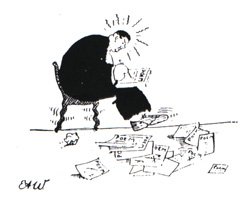
- Cartoon by Eudora Welty
Back in 1975, administrative changes in the library transformed the old "Mississippi Collection" into the Department of Archives and Special Collections. Along with new personnel, including a University Archivist to head the department, a fundamental change in collecting policy occurred. Rather than seeking only printed Mississippiana, we began to acquire private and corporate papers, literary manuscripts, and Mississippiana in a variety of non-book formats including maps, broadsides, sheet music, photographs, and ephemera.
Strengthening the Faulkner collection was an immediate goal. In 1981, Special Collections obtained the Rowan Oak papers, comprising 1,800 sheets of autograph and typescript drafts by Faulkner of poems, short stories, film scripts, and novels. These papers, discovered in a broom closet at Faulkner's home are the crown jewels of our collection.

- William Faulkner's Birth Announcement
Other major literary gifts and acquisitions soon followed, including the Wynn-Faulkner poetry collection and the papers of Henry and Katherine Bellamann, Herschell Brickell, Larry Brown, Ellen Douglas, Beth Henley, and Willie Morris.
Documenting the progress of Civil Rights in Mississippi is another area of particular interest. Several key donations--notably from Russell Barrett, James Silver, Ed King, and James Howard Meredith--significantly augmented our holdings.
Selecting materials to include in the anniversary exhibition has been a daunting if pleasurable undertaking. Wherever possible we have chosen printed items that are unique to Special Collections. We have also sought to strike something of a balance between historical Mississippiana and literary material, and to show as many examples as possible of the great variety of formats collected. -- Thomas M. Verich, University Archivist
Antebellum and Civil War Mississippi
![Plantation Ledger. "Cotton Book." Locust Grove Plantation [Jefferson County, Mississippi]. 1825-1845.](https://exhibit-production-digitalcommons.s3.amazonaws.com/images/ledger.width-500.jpg)
- Plantation Ledger. "Cotton Book." Locust Grove Plantation [Jefferson County, Mississippi]. 1825-1845.
Internal evidence suggests that the Postlewaite family of Mississippi owned the Locust Grove Plantation named in the ledger. Entering the territory in the early 1800s, Samuel Postlewaite became a successful merchant and planter as well as a founder of the Bank of Mississippi. At his death in 1825, an heir adopted a fairly common accounting practice of the time--recording daily amounts of cotton picked by each named slave. Occasionally, other chores such as "digging potatoes" or weather ("rain...rain...rain") interrupted the harvest of this cash crop. The leather bound volume also contains remedies for ailments as well as a "List of Negroes in Families on Locust Grove Plantation, Jany 1st, 1828," with notations on marriages, births, and deaths.
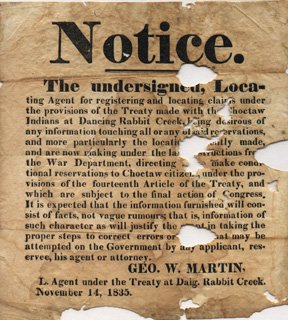
- Broadside. George W. Martin. "Notice. The undersigned, Locating Agent for registering and locating claims under the provisions of the Treaty made with the Choctaw Indians at Dancing Rabbit Creek..." 14 November 1835. 23 x 21 cm.
Starting in 1786, the Choctaw Nation negotiated nine separate treaties with the federal government, culminating in the 1830 Treaty of Dancing Rabbit Creek. Under its terms, the tribe agreed to relinquish ten and half million acres in return for relocation to Indian Territory. Article 14 of the treaty, however, guaranteed land allotments in Mississippi to Choctaws who wished to remain in the state so long as they registered within six months. The fraudulent tactics of the Indian Agent in charge of this procedure provoked several government investigations over the years. This unique 1835 broadside was directed at Choctaws who might wish to register Mississippi land claims denied them five years earlier.
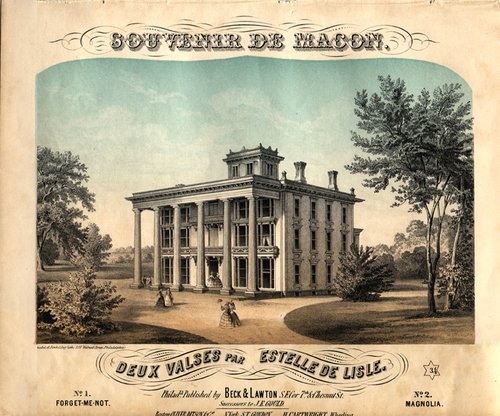
- Sheet Music. Estelle de Lisle. Magnolia: Valise Elegante. Philadelphia: Beck & Lawton, 1859. Title on front cover: Souvenir de Macon. Deux Valses par Estelle De Lisle. Cover illustrated with a tinted lithograph depicting the Calhoun Female Institute at Macon, Mississippi.
The Calhoun Female Institute began as a public school for girls in the early 1850s. By 1858, the director changed the facility to a private operation in order to pursue a loftier curriculum: "the basis and system of Calhoun Institute, as applied to female education, are new; but, as mind knows no sex, it is as suitable in the education of females as males." The rare, colored illustration on the cover of this antebellum sheet music depicts a dormitory completed in 1858. Three stories high, the building also included an observatory for astronomical research. In 1863, Macon became Mississippi's wartime capitol, and the school's campus served as the seat of government. Special Collections owns the only recorded copy of this sheet music.
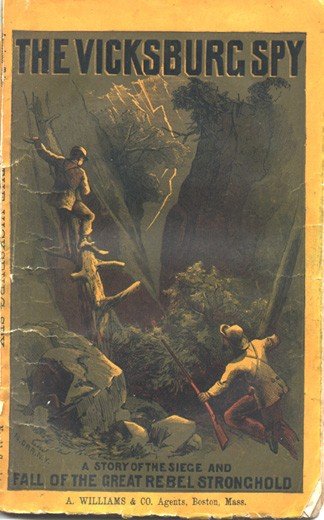
- Edward Willett. The Vicksburg Spy: Or, Found and Lost. A Story of the Siege and Fall of the Great Rebel Stronghold. New York: The American News Co., Publishers' Agent, 1864.
This rare piece of Union propaganda printed a year after the fall of Vicksburg features an engaging set of characters: the crafty yet warm-hearted former trapper and Union scout, Bill Woodworth; his son Henry, who serves as a Union spy under the alias "Pete Purcell"; and Lieutenant Sollis, the vengeful Confederate soldier from "the best blood of Alabama." Two damsels in distress, Kate and Bessie Sharp, sympathize with the Union and fall in love with two Federal soldiers. After much intrigue and plotting the Confederate villain dies and the Union cause triumphs. Unfortunately, Henry is mortally wounded in his efforts to save his lady love, Kate Sharp. The ending is pure melodrama featuring a tearful reunion between father and son, the hoisting of the "Stars and Stripes" over Vicksburg, and the final passing of Henry while Kate weeps.
Late Nineteenth Century Mississippi
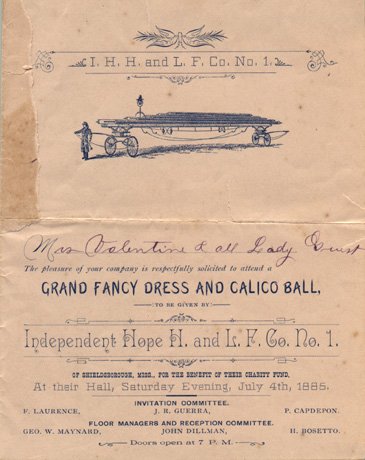
- Printed Invitation. "Grand Fancy Dress and Calico Ball, To Be Given By: Independent Hope H[ook]. and L[adder]. F[ire]. Co. No.1." Shieldsborough, Mississippi. 4 July 1886. With admission ticket.
This charming invitation is made out by hand to "Mrs. Valentine & all Lady Guest[s]" and includes an engraving of a late nineteenth-century fire engine. A printed admission ticket accompanies the invitation.
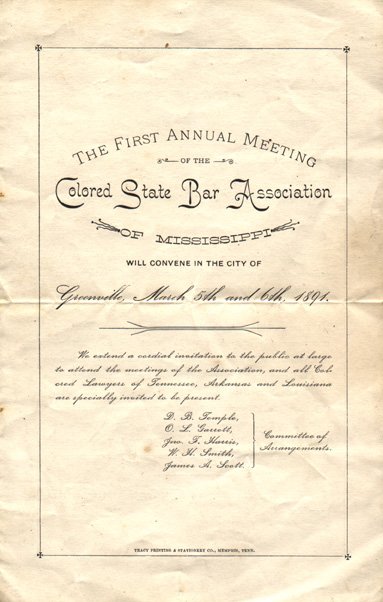
- Program. "The First Annual Meeting of the Colored Bar Association of Mississippi Will Convene in the City of Greenville, March 5th and 6th, 1891." Memphis: Tracy Printing & Stationery Co.
Apparently, our copy is the only surviving example documenting this professional meeting of black lawyers. During the two-day meeting, a number of papers "not to occupy over twenty minutes," were offered on topics including "The Negro as a Law Maker," "Capital Punishment," and "Tax Titles." The program also scheduled a one-hour discussion to follow the main address on Mississippi's 1890 Constitution.

- Program. "Report of the Organization of the Mississippi Woman Suffrage Association. Meridian, Mississippi. May 5th, 1897."
This program, the only recorded copy, lists the newly elected officers for the Mississippi Woman Suffrage Association celebrating "the first convention ever held in Mississippi in the interest of Woman Suffrage." Noteworthy are the listings for the President, Mrs. Robert Somerville, and one of the Vice-Presidents, Miss Belle Kearney. Both of these women would later serve in the Mississippi State Legislature.
Twentieth Century Mississippi
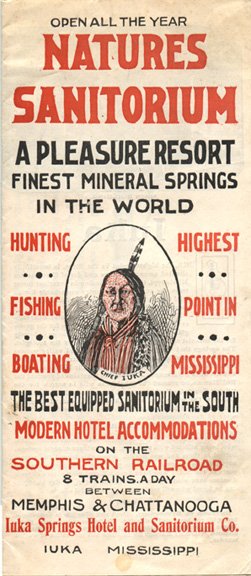
- "Open All the Year/ Nature's Sanitorium/ A Pleasure Resort, Finest Mineral Springs in the World/ Hunting, Fishing, Boating/ Highest Point in Mississippi/ The Best Equipped Sanitorium in the South/ Modern Hotel Accommodations on the Southern Railroad, 8 Trains a Day Between Memphis & Chattanooga/ Iuka Springs Hotel and Sanitorium Co./ Iuka, Mississippi." c. 1890-1900.
Located in the northeastern corner of the state, the Iuka Sanitorium appealed to anyone who might benefit from the spa's five mineral springs. Of these, the resort boasted that "Here are the fountains of youth of the Red Man as he roamed the inhabitless [sic] wild in search for the 'Spirit Fountains.'" Also available to patrons were various electro-therapeutic treatments, and this previously unrecorded pamphlet contains numerous illustrations of these pseudo-scientific devices.
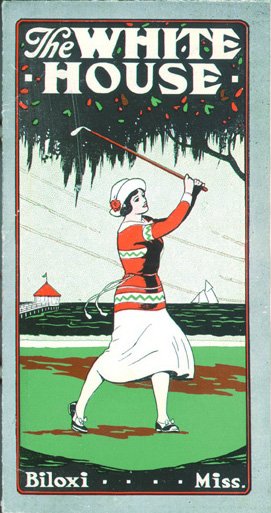
- Pamphlet. "The White House/ Biloxi, Miss." undated.
"On the Coast one loses/ Fear of winter days,/ For the sun diffuses/ Ultra-Violet Rays." Balmy weather has drawn vacationers to the Mississippi shore since before the Civil War. By the twentieth century, numerous luxury hotels like The White House vied for visitors by touting various attractions--including access to five eighteen-hole courses on "the Golf Coast."
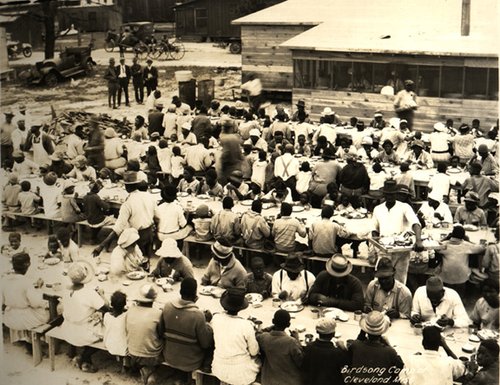
- Photograph Album. "The Mississippi River Flood of 1927. Mounds & Cairo, Ill. To New Orleans, La." Illinois Central Railroad Company, 1927.
With nearly 400 prints and proofs, this album documents the routes taken by the Illinois Central Railroad "Flood Committee" to survey damage to their tracks and depots. Mississippi locales constitute the majority of these images. Reproduced here is a photograph of the African-American refugee camp at Cleveland, Mississippi on April 29th showing residents dining outdoors.
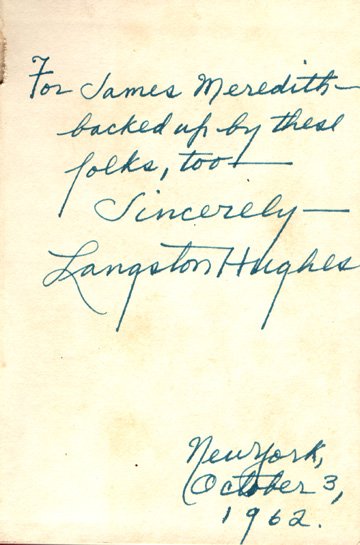
- Langston Hughes. Famous Negro Heroes of America. New York: Dodd, Mead & Company, 1960. 2nd printing. With dust jacket. Inscribed by Hughes: "For James Meredith-backed up by these folks, too-Sincerely-Langston Hughes/ New York, October 3, 1962."
After a tour of duty abroad in the U.S. Air Force, James Meredith returned to his home state determined to attend the University of Mississippi. The state, under Governor Ross Barnett, adopted several measures to prevent the black veteran's admission. Meredith enrolled at Ole Miss only after a protracted court battle and a campus riot suppressed by federal troops. Letters of support for the young man arrived from all over the world: Rosa Parks, whose refusal to surrender her seat sparked the Montgomery Bus Boycott, sent a postcard; Western Union delivered a message from celebrity Josephine Baker; author Langston Hughes wrote an inscription that compared Meredith to the subjects of Hughes's Famous Negro Heroes of America; and Mississippi NAACP President Aaron Henry expressed his admiration of Meredith's "courage and determination" in a typed letter. In 1997, James Howard Meredith donated his extensive papers to his alma mater.
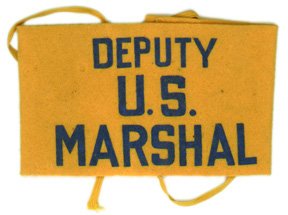
- "Deputy U.S. Marshal Armband." 1962.
On the afternoon before Meredith's registration, a crowd had already begun to gather outside the Lyceum to confront the U.S. Marshals sent to keep order on the campus. Later that evening, an angry mob of whites would assault the marshals with bricks and bullets until the arrival of federal troops quelled the riot in the early morning hours. The final tally of that confrontation: two bystanders dead, 206 wounded marshals and soldiers, 200 individuals arrested, and one African-American student enrolled at the University of Mississippi.
Book of Gold

- Manuscript Book. Eric A. Dawson. "Foyer Du Soldat De Pierrefitte" Title on spine: "The Book of Gold."
An extraordinary autograph album and scrapbook, Eric Dawson kept "The Book of Gold" throughout much of his adult life. A Mississippi native, Dawson graduated from the University of Mississippi in 1908. Later he taught French at his alma mater. During World War I, Dawson served with the American YMCA in its "Foyers des Soldat" (Soldier's Club) program in France. Initially he worked in Pierrefitte, a small village in the Lorraine where Dawson began his unique book by inscribing "Foyer de Soldat de Pierrefitte" on the title page. In 1918, he joined the United States Army as a private, later becoming a sergeant in the Intelligence Corps. Beginning in the First World War and continuing through the early 1940s, Dawson collected a dazzling array of signatures, autograph sentiments, signed musical notations, autograph poems, pen and pencil drawings, watercolor sketches, political documents, original photographs, and war-time ephemera. The sampling of pages on display only hints at the range, variety, and color of the album as a whole. Many important writers (Ezra Pound, Thomas Mann, Rudyard Kipling, and William Faulkner), political and military figures (Winston Churchill, Marshall Foch, John Pershing, Douglas McArthur, and Woodrow Wilson with five members of the American delegation to the Paris Peace Conference), composers (W.C. Handy, Cole Porter, Igor Stravinsky, Irving Berlin, and Sergei Rachmaninoff), figures from the arts (Howard Chandler Christy and Henri Matisse) and sciences (Albert Einstein), as well as from film and stage (Sarah Bernhardt, Lillian Gish, and Tallulah Bankhead) and sport (Jack Dempsey) have all contributed to Dawson's amazing book.
Literary Mississippiana
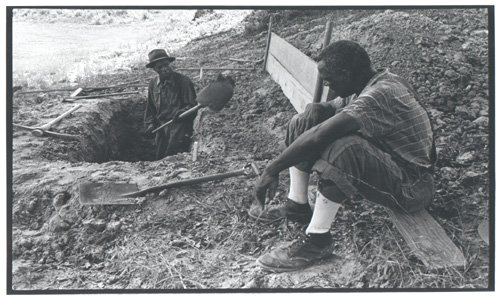
- Photograph. Martin J. Dain. [Faulkner's Grave]. 7 July 1962. 20 x 30 cm.
A successful commercial photographer in New York, Martin Dain visited Lafayette County several times in the early 1960s, attempting to capture on film scenes evoking Faulkner's Yoknapatawpha. In the spring of 1962, he returned to Oxford to document Faulkner's funeral--including this previously unpublished glimpse of gravediggers preparing the author's final resting place in St. Peter's Cemetery. Dain's photographs of Faulkner and Mississippi have achieved wide circulation over the last thirty years, notably in his book Faulkner's County: Yoknapatawpha (1964) and the work Faulkner's World: The Photographs of Martin J. Dain (1997). The University of Mississippi acquired the Dain Collection, comprising over 8,000 negatives in 1993.
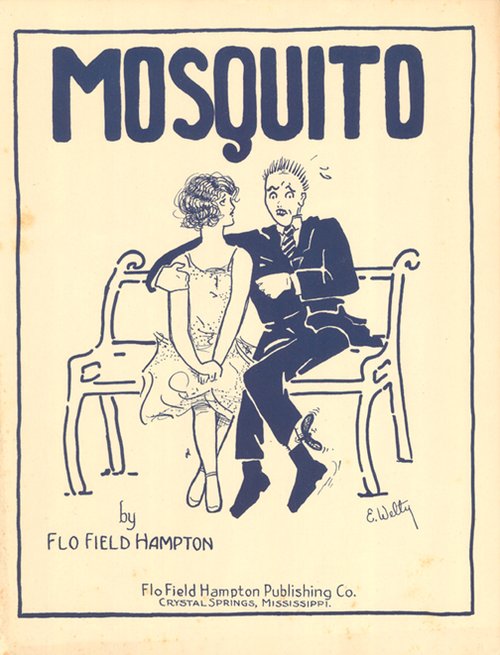
- Sheet Music. Mosquito. By Flo Field Hampton; arranged by Harry L. Alford. Crystal Springs, Mississippi: Flo Field Hampton Publishing Co., c. 1926.
Eudora Welty illustrated the cover for this musical piece written by Flo Field Hampton, her English teacher at Jackson Junior-Senior High School: "O Mos-qui-ta, Mos-qui-ta, you bi-ta my feet-a!" This rare piece of Welty juvenilia is the only recorded copy.
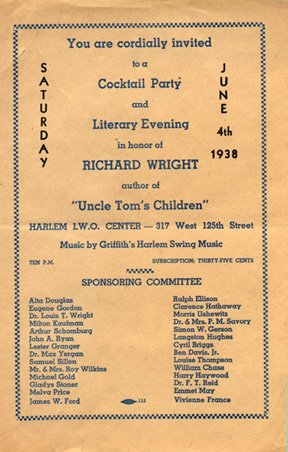
- Broadside. "You are cordially invited to a Cocktail Party and Literary Evening in honor of Richard Wright author of 'Uncle Tom's Children'/ Harlem I.W.O. Center-317 West 125th Street/ Saturday/ June 4th 1938." 21x14 cm.
Among the list of sponsors for this subscribed event are Langston Hughes, Mr. & Mrs. Roy Wilkins, Arthur Schomburg, and Ralph Ellison.
